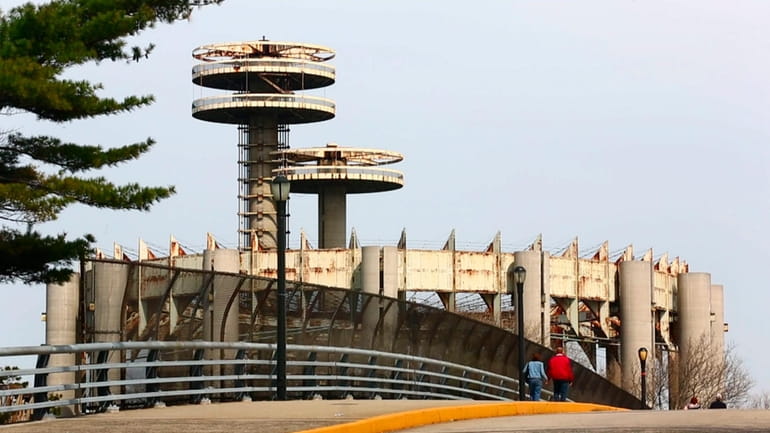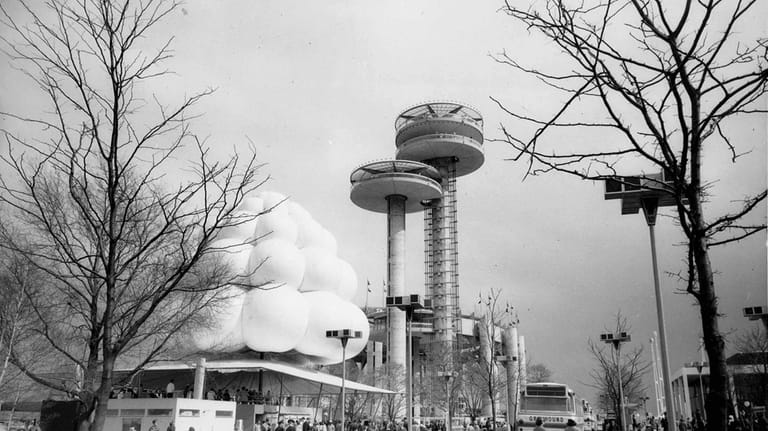Restoration aims to restore luster of decaying 1964 World's Fair pavilion

The 51 million people who attended the 1964 World's Fair over two seasons at Flushing Meadows-Corona Park set a world record for an international exposition.
The guests included the Rev. Martin Luther King Jr. and his family, the ground having been broken by then-President John F. Kennedy before his assassination. The fair's symbol was dedicated to “Man's Achievement on a Shrinking Globe in an Expanding Universe.”
Yet while the fair was a notable achievement for its time, the structures it left behind — towering and ultramodern in their day — are now rusted and worn after decades of neglect. To most passersby, they are a mysterious remnant of a bygone era.
Parts of the pavilion were initially meant to be torn down, but the hulking structures remained, devolving into a state of disrepair. Now, as the 60th anniversary of the 1964 World's Fair is celebrated, there is hope the structures can someday spring back to life, both to shore up stability of the decaying steel and to show off what were once touted as architectural marvels.
While there have been efforts over the decades to restore and refurbish the World's Fair Pavilion’s Tent of Tomorrow and Towers — the structures can be clearly seen from the highway — those efforts have largely been halting and unproductive.
“When something is not being used, it's not maintained, and so it can rapidly fall into disrepair, and so that’s one of the big challenges with the observation towers and the Tent of Tomorrow,” said Evan Kopelson, a partner with Vertical Access LLC in Ithaca, who's worked on the project in the past.
He added: “Even though the structures are in a deteriorated condition and haven’t been used for probably 40 or 50 years, I think you still get a sense of what they were originally built for, and that’s pretty amazing.”
Now, finally, there is construction underway to try and restore the site, at least partially, to its original glory.
The towers were closed right after the fair ended. But the tent was used for activities such as music and art shows and a roller-skating rink and then closed in 1974, said Kopelson, who is a visiting lecturer at Cornell University's historic preservation program.
Chris Clark, a spokesman for the New York City Parks Department, said construction began in October on a project to rebuild part of the towers. The project aims to repair deteriorated steel elevator rails and roof frames, create new concrete decks at all tower levels, replace railings and steel fascia, paint steel sections of the towers, and finish concrete repairs, he said.
There also will be work to address underlying causes of the deterioration of steel and waterproofing to prevent deterioration in the future.
This is the second and final phase of the project, which is expected to be done in the fall of 2025, Clark said. The total cost is $56.756 million for both phases, he said. The Parks Department, he added, hopes to offer limited public access via guided tours of the Towers. He said there won't be public access inside the tent.
“For nearly 60 years the NYS Pavilion’s Tower and Tent of Tomorrow has stood tall above Queens’ beloved jewel, Flushing Meadows-Corona Park, representing hope during challenging and changing times,” said a statement sent by Clark from Anthony Sama, a parks administrator and executive director of the Alliance for Flushing Meadows-Corona Park. “This critical stabilization project will ensure the towers are safe for future generations to enjoy.”
The pavilion, designed by the architect Philip Johnson for the 1964 World's Fair, includes the 350-by-250-foot Tent of Tomorrow, supported by 16 columns that are 100 feet tall, with three tiered observation towers that rise 60, 150 and 226 feet.
In 2018, only two construction companies responded to a bid that had gone out earlier in the year, and neither was deemed viable by the Parks Department.
The next year, the Parks Department announced that some work would begin — and then the pandemic hit.
And last year, with great fanfare, the Parks Department celebrated the completion of the first phase of rehabilitation work on the tent and towers. The big news: The site would be illuminated in “parks green” occasionally.
The Tent of Tomorrow once had the world’s largest cable-suspension roof. At the park earlier this month, the towers were clad in scaffolding and fenced in by construction. Rusting paint chipped from the tent’s crown.
Few passersby seemed to know much about what was once a marvel, and those who did spoke about it as ruins from a bygone time.
A chef of vegan food named Ruben Calvo, 33, of Middle Village, was strolling past the site recently with his girlfriend. Neither of them really knew what the structures were for, but Calvo, who comes to the park “every chance I get” and has for years, said he knows there’s been renovation going on there “for years.”
“I had no idea about the Towers of Power,” Calvo said. “I thought it was a laser canon … Honestly, I thought it was, like maybe, a giant sundial or something, cause I know the Hall of Science is close by.”
Albert Pozotrigo, 72, an engineer who lives in New Jersey and was enjoying the park on another side of the towers, said he appreciates the structures in their current state.
Pozotrigo acknowledged a renovated site would be nicer. “Something beautiful is always better. You go to Paris. You’re looking all around all the time,” he said.
Still, Pozotrigo said, gesturing to the rusted tent top and the scaffolding-clad towers, “I see a little bit of beauty in between the trees.”
The 51 million people who attended the 1964 World's Fair over two seasons at Flushing Meadows-Corona Park set a world record for an international exposition.
The guests included the Rev. Martin Luther King Jr. and his family, the ground having been broken by then-President John F. Kennedy before his assassination. The fair's symbol was dedicated to “Man's Achievement on a Shrinking Globe in an Expanding Universe.”
Yet while the fair was a notable achievement for its time, the structures it left behind — towering and ultramodern in their day — are now rusted and worn after decades of neglect. To most passersby, they are a mysterious remnant of a bygone era.
Parts of the pavilion were initially meant to be torn down, but the hulking structures remained, devolving into a state of disrepair. Now, as the 60th anniversary of the 1964 World's Fair is celebrated, there is hope the structures can someday spring back to life, both to shore up stability of the decaying steel and to show off what were once touted as architectural marvels.
WHAT TO KNOW
- Once heralded as world-renown gems, the Tent of Tomorrow and Towers from the 1964 World's Fair have fallen into disrepair and disuse.
- Construction began in October on a project to help restore the towers.
- To some passersby, the towers are a mystery, a relic of a bygone time.
While there have been efforts over the decades to restore and refurbish the World's Fair Pavilion’s Tent of Tomorrow and Towers — the structures can be clearly seen from the highway — those efforts have largely been halting and unproductive.
“When something is not being used, it's not maintained, and so it can rapidly fall into disrepair, and so that’s one of the big challenges with the observation towers and the Tent of Tomorrow,” said Evan Kopelson, a partner with Vertical Access LLC in Ithaca, who's worked on the project in the past.
He added: “Even though the structures are in a deteriorated condition and haven’t been used for probably 40 or 50 years, I think you still get a sense of what they were originally built for, and that’s pretty amazing.”

The towers of the New York State Pavilion soar above the fairgrounds. Architects Philip Johnson, Richard Foster and engineer Lev Zetlin created one of the most highly acclaimed structures at the fair. Credit: Queens Historical Society
Now, finally, there is construction underway to try and restore the site, at least partially, to its original glory.
The towers were closed right after the fair ended. But the tent was used for activities such as music and art shows and a roller-skating rink and then closed in 1974, said Kopelson, who is a visiting lecturer at Cornell University's historic preservation program.
Chris Clark, a spokesman for the New York City Parks Department, said construction began in October on a project to rebuild part of the towers. The project aims to repair deteriorated steel elevator rails and roof frames, create new concrete decks at all tower levels, replace railings and steel fascia, paint steel sections of the towers, and finish concrete repairs, he said.
There also will be work to address underlying causes of the deterioration of steel and waterproofing to prevent deterioration in the future.
This is the second and final phase of the project, which is expected to be done in the fall of 2025, Clark said. The total cost is $56.756 million for both phases, he said. The Parks Department, he added, hopes to offer limited public access via guided tours of the Towers. He said there won't be public access inside the tent.
“For nearly 60 years the NYS Pavilion’s Tower and Tent of Tomorrow has stood tall above Queens’ beloved jewel, Flushing Meadows-Corona Park, representing hope during challenging and changing times,” said a statement sent by Clark from Anthony Sama, a parks administrator and executive director of the Alliance for Flushing Meadows-Corona Park. “This critical stabilization project will ensure the towers are safe for future generations to enjoy.”
The pavilion, designed by the architect Philip Johnson for the 1964 World's Fair, includes the 350-by-250-foot Tent of Tomorrow, supported by 16 columns that are 100 feet tall, with three tiered observation towers that rise 60, 150 and 226 feet.
In 2018, only two construction companies responded to a bid that had gone out earlier in the year, and neither was deemed viable by the Parks Department.
The next year, the Parks Department announced that some work would begin — and then the pandemic hit.
And last year, with great fanfare, the Parks Department celebrated the completion of the first phase of rehabilitation work on the tent and towers. The big news: The site would be illuminated in “parks green” occasionally.
The Tent of Tomorrow once had the world’s largest cable-suspension roof. At the park earlier this month, the towers were clad in scaffolding and fenced in by construction. Rusting paint chipped from the tent’s crown.
Few passersby seemed to know much about what was once a marvel, and those who did spoke about it as ruins from a bygone time.
A chef of vegan food named Ruben Calvo, 33, of Middle Village, was strolling past the site recently with his girlfriend. Neither of them really knew what the structures were for, but Calvo, who comes to the park “every chance I get” and has for years, said he knows there’s been renovation going on there “for years.”
“I had no idea about the Towers of Power,” Calvo said. “I thought it was a laser canon … Honestly, I thought it was, like maybe, a giant sundial or something, cause I know the Hall of Science is close by.”
Albert Pozotrigo, 72, an engineer who lives in New Jersey and was enjoying the park on another side of the towers, said he appreciates the structures in their current state.
Pozotrigo acknowledged a renovated site would be nicer. “Something beautiful is always better. You go to Paris. You’re looking all around all the time,” he said.
Still, Pozotrigo said, gesturing to the rusted tent top and the scaffolding-clad towers, “I see a little bit of beauty in between the trees.”
No new drums found at Bethpage Park ... Urologist convicted of sexual abuse ... Knicks win game 2 ... Cafeteria inspections
No new drums found at Bethpage Park ... Urologist convicted of sexual abuse ... Knicks win game 2 ... Cafeteria inspections

